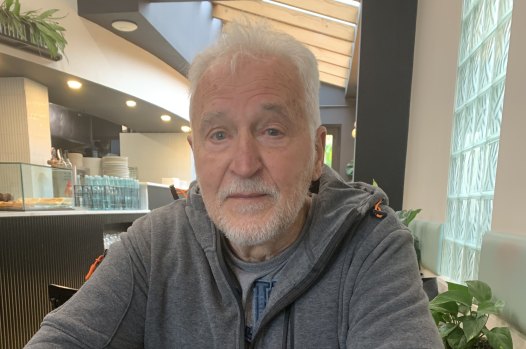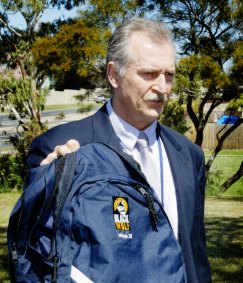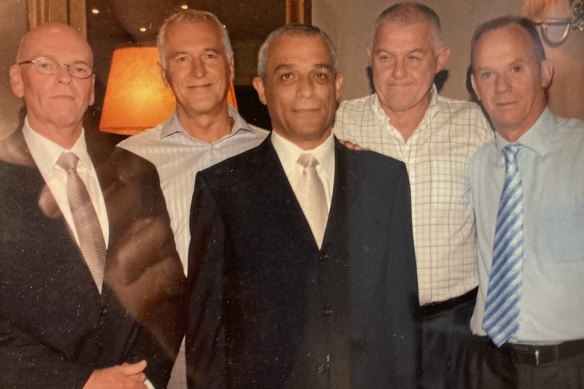- Analysis
- National
- Victoria
- Naked City
This was published 3 months ago
He was one of Victoria’s top homicide detectives. Working too hard cost him the job he loved
The recurring nightmare was the sign that 25 years of homicide investigations had taken a toll. Night after night he was a killer who meticulously buried his victim.
He would wake terrified. What have I done? Will I be caught? Will I be exposed and be disgraced?

A coffee with Lucio Rovis.Credit: John Silvester
It was only when Lucio Rovis went to visit a friend and colleague receiving treatment for post-traumatic stress disorder that his mate said the repeat dream was a classic symptom of PTSD.
“You think you are in control, but it does knock you around,” he says.
Rovis, now 75, spent seven years working in the brand-new industry of IT when computers were as big as a small van. It may have been intellectually challenging, but it was dead boring.
“There was no satisfaction because you didn’t interact with people.”
His wife’s uncle was a policeman, and in 1976 Rovis joined the police force. At 26, he was the oldest in his intake.
For a cop who would be entrusted with some of the most difficult investigations imaginable, his career nearly stalled at the start.
Legendary AFL coach Allan Jeans was also the senior sergeant in charge of the freshly graduated cops who were sent to live in at Russell Street police headquarters. Jeans’ job was to knock them into shape with a little barrack-room discipline.
Jeans ran an experienced eye over the young Rovis, who was fresh from a couple of night shifts, and didn’t like what he saw. “At parade he said my hair was too long, and my pants weren’t creased properly.”
Jeans had him shipped off to the transport branch to work as a glorified valet, ferrying police cars between depots. Rovis was on night shift and bored when another young cop came in. Rovis encouraged the young officer to grab a police motorbike and take it for a joyride inside the large vehicle building.
“He crashed and broke his leg.” The injured cop immediately blamed Rovis, who was sacked from transport duties and sent back to Russell Street.
It was then that he started real policing, working at Collingwood, Prahran crime cars and then the major crime squad.
At Collingwood, Rovis formed an unlikely alliance with the radical-left, draft-dodging doctor (later professor) Nick Crofts from the local Community Health Centre.
They became a team when neighbours called emergency services after they became aware of an elderly woman who needed help. She had been lying motionless on her couch for days.

Detective Senior Sergeant Lucio Rovis holds a backpack found at a murder scene.Credit: John Woodstra
“She had scurvy and needed to go to hospital,” Crofts recalled. While she was recovering, Crofts and Rovis (always handy on the tools), took it upon themselves to fix her house.
Rovis says the woman may have been frail, but she was far from helpless. “She was shrewd as,” he says. “She was always ringing saying something needed to be fixed. I ended up nearly renovating her whole house. She played me on a break.”
During his stint with major crime he was encouraged to apply for the homicide squad, where he worked hundreds of cases, first as a senior detective, then a detective sergeant and finally as the head of a crew as a detective senior sergeant.
Murder investigations need a special type of cop: one prepared to work long stints; sacrifice segments of their personal life; deal with horrific sites while showing compassion for the families of victims and, at times, empathy for the offenders.
Rovis was one of a series of crew leaders who became the spine of the squad. They included Jeff Maher, Ron Iddles, Rowland Legg and Charlie Bezzina.
The five stayed for years, refused to seek promotion, and became mentors to dozens of detectives. Because they were the ones who held the press conferences at murder scenes, they had higher profiles than many of their bosses.
Eventually, for a number of reasons, these high profiles would work against them.
Rovis was thrown in the deep end. His first investigation was the December 1985 mafia contract hit on Geelong pizza shop owner John Francis Di Quinzio. His body was found in sand dunes at Barwon Heads the following January, and the shotgun used to kill him was recovered from nearby Lake Connewarre.
“He went out and just didn’t come home,” says Rovis.
Back then there were no CCTV, DNA or detailed credit card checks, and so homicide detectives had to gather information in different ways.

The Big Five: Rowland Legg, Lucio Rovis, Charlie Bezzina, Ron Iddles and Jeff Maher.
Police believed another man was present when Di Quinzio was abducted, but he was saying nothing.
While he would not tell police what happened, detectives believed the man had confided in his wife, and so they hypnotised her. “She was able to tell us what happened.”
But without the testimony of the witness, the case remains unsolved.
Sometimes it is the cases that don’t make headlines that have the greatest impact.
Such as the mentally disturbed 19-year-old boy who killed and dismembered a friend.
“He had drawn a stick figure on a piece of paper with 30 cuts. It was his blueprint of what he was going to do. When we got there, the carpet squelched with blood.”
The crime scene was compromised, because 30 people, mostly police having a sticky beak, went in to look around.
“I asked them why, and just about every one of them said, ‘I wanted to confirm he was dead.’ Well, the fact the victim’s head was in the bath was a pretty good clue,” says Rovis.
The offender did not stand trial because he was mentally unfit. “The poor bugger was delusional.”
The case that brings Rovis to tears is the mother who drowned her children, aged two and five, and then killed herself.
“That sort of stuff knocks you around,” he says.
He asked for a police psychologist to come to the station to assist all the police involved. “When I walked in, she said, ‘You’re from homicide, you don’t need a debrief,’ so I walked out.”
It was his homicide colleagues, he says, who provided the support. “You might work 40 hours straight and then have a crew lunch to talk it through. Honestly, you were so tired you would just have a couple of beers and go home.”
Rovis says the image of homicide detectives as big drinkers was a macho myth. “There were a couple who might have had a problem with alcohol, but work always came first.”
One of the reasons Rovis is speaking publicly is he feels some want to paint the homicide detectives of his era as less than professional. “There were so many great detectives who went through the squad, just champion blokes.”
The Big Five senior sergeants were able to interview and select new members of the squad, and Rovis is proud that he recruited women to break the all-male structure.
After more than 20 years in homicide, the whispers started that the Big Five senior sergeants were in trouble, and for Rovis, the criticism was not that he was no longer performing ,but that he was working too hard.
A man had attended a police station to report a murder, but the details were so sketchy he was fobbed off. When he returned with more details, Rovis and his crew took on the case.
A Gippsland man had been murdered, and his body dumped in forests near Mirboo North.
They started a search at a time when the police department was cracking down on excessive overtime. Rovis’ team had worked long hours, but if they knocked off they would have driven home, only to return the next day.
“We decided to push on and continue the search even though we weren’t going to be paid.”
In the darkness, one of the crew asked Rovis, “If we find the body, will you shout us a slab?”
“I said, ‘sure’ but what I didn’t know is that the bastard had already found it.”
Three men were charged and convicted of the murder.
Called into the bosses, he was expecting a pat on the back. Instead, he was criticised over the excessive hours.
In May 2008, he was called in with Charlie Bezzina and the pair were told they were to be transferred.
“I was enjoying the work and thought I could perform at the top of my game for another five years.”
Instead, he was transferred to a taskforce. “I would sign a few papers, go for a run, go to a movie in the afternoon and then go home.”
Eventually, the remaining three senior sergeants were moved.
Rovis was on sick leave when then chief commissioner Christine Nixon turned up at his house. “She offered my job back, but it was too late.” Rovis did not return to work and retired.
There are plenty of old-school cops prepared to criticise Nixon, but not Rovis.
“She really took on the issue of family violence. Young cops would be called to a job and just see it as a domestic and not record the details. We wanted a better system because we (homicide detectives) too often saw the end results,” he says.
“We wanted everything recorded so there would be a process for the victims to get out before it was too late.”
John Silvester lifts the lid on Australia’s criminal underworld. Subscribers can sign up to receive his Naked City newsletter every Thursday.